Welcome to our exploration of the captivating beauty of Vallisneria Neotropical, a stunning aquatic plant that adds a touch of natural artistry to any underwater landscape.
With its graceful, long, and narrow leaves in vibrant green hues, Vallisneria Neotropical effortlessly enhances aquariums’ aesthetic appeal and vitality.
Let us delve into the wonders of this remarkable underwater plant and discover its secrets.
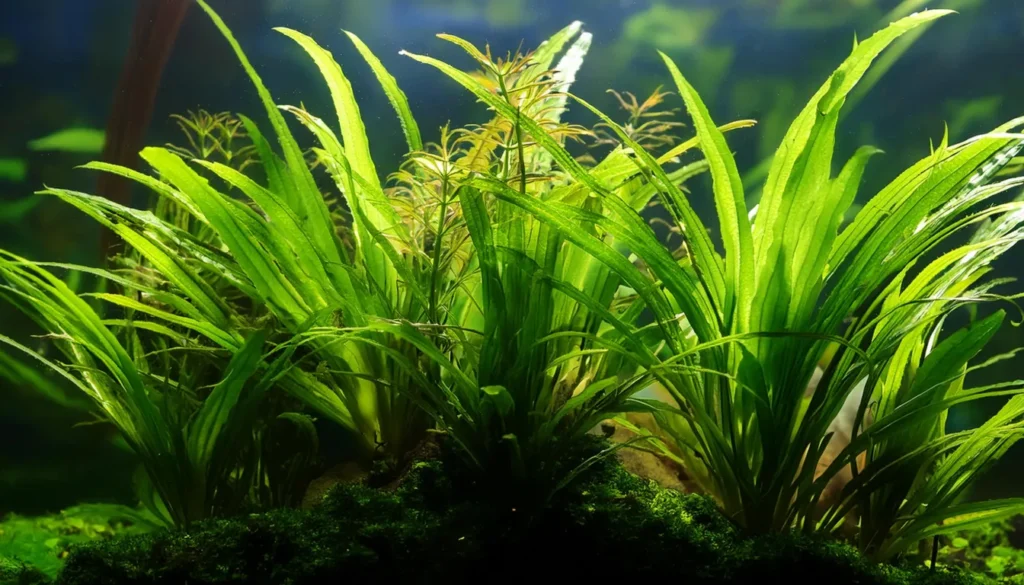
Key Takeaway
- Vallisneria Neotropical is an underwater plant known for its elegance and natural beauty.
- Its long and narrow leaves in vibrant green color effortlessly enhance the aesthetics of aquariums.
- Vallisneria Neotropical adds vitality to freshwater ecosystems, creating stunning underwater landscapes.
- To thrive, the plant requires suitable lighting, temperature, water conditions, and substrate.
- Propagating Vallisneria Neotropical is possible through division and runner methods.
Quick Stats
| Attribute | Details |
| Scientific Name | Various species within the Vallisneria genus |
| Common Name | Neotropical Vallisneria |
| Origin | Central and South America |
| Height | Varies depending on species |
| pH Range | Typically 6.5 – 8.5 |
| CO2 Requirement | Low to Medium |
| Growth Rate | Moderate to Fast |
| Care Level | Easy to Moderate |
| Color Form | Typically green |
| Water Conditions | 18-28°C (64-82°F), adaptable to various parameters |
| Max Size | Varies depending on species |
| Lighting | Low to Moderate |
| Supplements | Root tabs or liquid fertilizers beneficial |
| Placement | Background |
| Propagation | Through runners or division of rhizome |
What Is Vallisneria Neotropical?
This plant is a captivating aquatic plant that adds a touch of underwater beauty to aquariums.
With its vibrant green color and long, narrow leaves, this plant is a popular choice among aquarists looking to create a vibrant and natural underwater environment.
Natural Habitat And Origin
Vallisneria Neotropical, commonly known as Neotropical Tape Grass, is a fascinating aquatic plant that thrives in freshwater ecosystems.
It’s natural habitat and origin play a significant role in understanding its requirements and ensuring its successful cultivation in aquariums.
This species is native to various regions worldwide, including North and South America, Europe, Asia, and Africa.
It is found in many freshwater habitats, such as lakes, ponds, rivers, and streams.
Vallisneria Neotropical has the remarkable ability to adapt to different environmental conditions, making it a versatile and resilient plant.
Its origins can be traced back to the tropical and subtropical regions, where it has evolved well-suited to the diverse aquatic ecosystems in these areas.
With its ability to grow submerged in water, Vallisneria Neotropical plays a crucial role in maintaining the equilibrium of these ecosystems by providing oxygen, acting as a nutrient sink, and sheltering various aquatic organisms.

Physical Characteristics
In addition to its underwater elegance, Vallisneria Neotropical possesses fascinating physical characteristics that contribute to its aesthetic appeal and overall vitality. Let’s take a closer look at its root system, stem structure, and the presence of a rhizome.
- Root System: Vallisneria Neotropical’s root system is extensive and integral to its successful growth and stability. The plant develops a network of fine, fibrous roots that anchor it to the substrate, ensuring it remains firmly in place. These roots also absorb nutrients from the water column, aiding the plant’s overall health and development.
- Stem Structure and Rhizome: The stem of Vallisneria Neotropical is slender and elongated, with leaf blades growing directly from it. These leaf blades can reach impressive lengths, adding to the plant’s graceful appearance. Depending on the specific variety, the stem may have a slightly reddish or greenish hue.
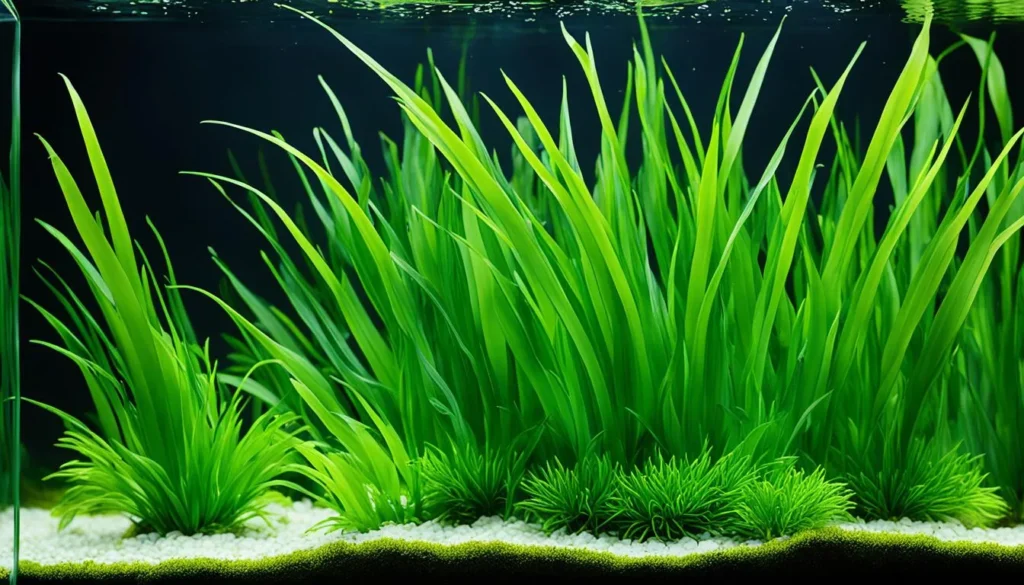
Lighting Demands Of The Plant
- Vallisneria Neotropical thrives in moderate to high levels of light. Adequate lighting is necessary to facilitate the plant’s photosynthesis process, enabling it to convert light energy into chemical energy needed for growth. Insufficient light may lead to stunted growth or the plant becoming weak and prone to disease.
- When selecting aquarium lighting for Vallisneria Neotropical, choosing a light fixture that provides a suitable intensity and spectrum is recommended. Full-spectrum LED lights or T5 fluorescent lights are often preferred options as they can deliver the required light intensity and color spectrum beneficial for photosynthesis.
- It is important to consider the size and depth of the aquarium when determining the lighting needs. Deeper tanks may require stronger lighting to ensure that light can penetrate to the lower parts of the tank, reaching the Vallisneria Neotropical effectively.

Temperature Parameters
- When it comes to cultivating Vallisneria Neotropical, understanding its temperature parameters is crucial for ensuring optimal growth. This aquatic plant is adaptable to different temperature conditions, making it suitable for a wide range of aquarium setups.
- The optimal temperature range for Vallisneria Neotropical lies between 13°C and 38°C, providing the ideal conditions for its growth and development. Within this temperature range, the plant can thrive and exhibit its full potential.
Water Condition For Optimal Growth
- pH Level: Vallisneria Neotropical prefers slightly acidic to neutral water with a pH level ranging from 6.5 to 7.5. Maintaining a stable pH level within this range is crucial for promoting healthy growth.
- Water Hardness: This plant adapts well to a wide range of water hardness. However, moderate to slightly hard water with a hardness level of 6 to 12 dGH is generally recommended for optimal growth.
- Nutrient Levels: Vallisneria Neotropical requires sufficient essential nutrients to thrive. Proper nutrient levels in the water are important to support healthy leaf development and overall plant vigor. Regular fertilizer dosing or using nutrient-rich substrates can help fulfill the plant’s nutritional requirements.
Substrate Requirement
- Gravel: Gravel is a popular substrate choice for planted aquariums due to its versatility and ability to hold nutrients. The coarse texture of gravel allows for better water circulation, preventing debris accumulation and ensuring adequate roots oxygenation. It also provides a stable base for the Vallisneria Neotropical to anchor and spread its long, narrow leaves.
- Sand: Sand is another suitable substrate option for Vallisneria Neotropical. It offers a more aesthetic appeal with its fine texture and smooth appearance. Sand provides a gentle bed for the plant’s delicate root system and allows for easier nutrient absorption. However, it is important to choose sand that is not too compact to ensure proper water flow and prevent anaerobic conditions.
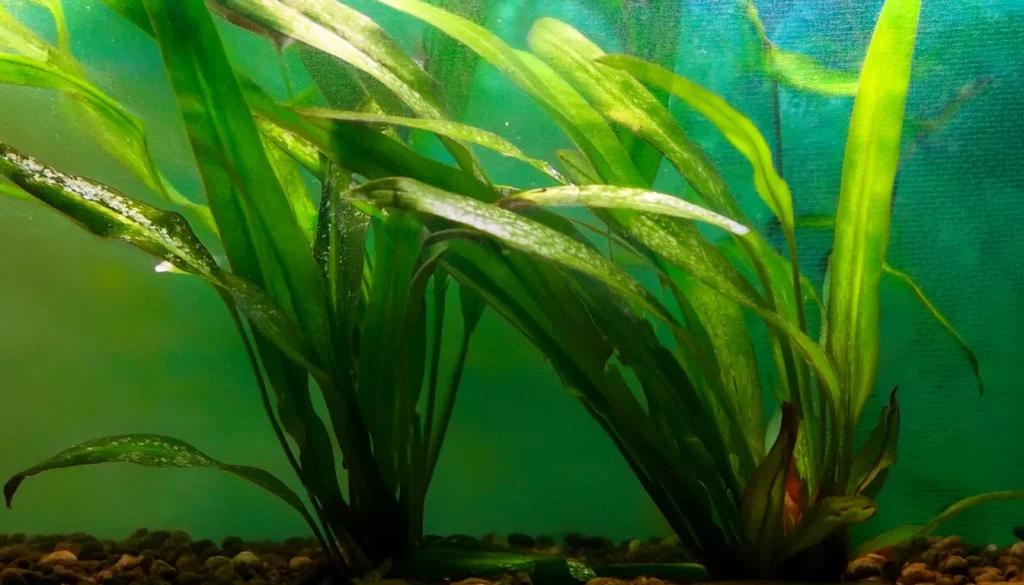
Placement Option
- When it comes to positioning Vallisneria Neotropical in your aquarium, you have two main options: using it as a background plant or as a centerpiece plant.
- If you choose to use Vallisneria Neotropical as a background plant, it will serve as a lush, green backdrop for your aquarium. This aquatic plant’s long and narrow leaves create a beautiful curtain-like effect, adding depth and visual interest to the tank. By placing Vallisneria Neotropical in the background, you can create a sense of depth and enhance the overall aesthetic appeal of your aquarium.
- On the other hand, if you want to make Vallisneria Neotropical the focal point of your aquarium, you can use it as a centerpiece plant. Its vibrant green color and graceful appearance make it a stunning centerpiece that draws attention and becomes a focal point of the tank. Placing Vallisneria Neotropical in the center of the aquarium allows you to showcase its beauty and create a visually striking display.
Recommended Tank Size
- When considering Vallisneria Neotropical for your aquarium, choosing the right tank size is important to provide enough space for this beautiful aquatic plant to thrive. The recommended tank size depends on its growth potential and space requirements.
- Vallisneria Neotropical is known for its long and narrow leaves that can grow quite tall, reaching up to **two feet**. Therefore, it is advisable to have a tank with a sufficient height to accommodate the full growth of this plant. **A tank with a height of at least 18 inches** or more is recommended to allow Vallisneria Neotropical to display its beauty in its entirety.
- Regarding floor space, Vallisneria Neotropical does not require a large footprint. It is a relatively compact plant that can be grown in aquariums with dimensions as small as **14 inches by 8 inches**. However, keep in mind that providing more room for the plant to spread its leaves will enhance its visual impact and create a more natural-looking underwater environment.
Recommended Tank Sizes for Vallisneria Neotropical
| Tank Dimensions (in inches) | Recommended Tank Size |
| 14 x 8 x Height 18 | Minimum recommended tank size |
| 18 x 10 x Height 24 | Optimal tank size for a visually appealing display |
| 24 x 12 x Height 30 | Large tank size for impressive growth and spreading |
Suitable Tank Mates For Vallisneria Neotropical
When creating a thriving aquarium ecosystem, it’s important to consider the tank mates for Vallisneria Neotropical.
Choosing suitable companions ensures a harmonious community tank and promotes the overall well-being of the aquatic environment.
When selecting tank mates, it’s crucial to prioritize peaceful fish species that won’t disturb or harm Vallisneria Neotropical.
The gentle nature of these fish will prevent any damage to the delicate leaves and roots of the plant.
In a community tank, peaceful fish species that form compatible companions with Vallisneria Neotropical include:
- Tetras (such as Neon Tetras and Cardinal Tetras)
- Livebearers (such as Guppies and Platies)
- Dwarf Gouramis
- Corydoras Catfish
- Rasboras
- Swordtails
These species are known for their peaceful temperament and are unlikely to nibble on or uproot the Vallisneria Neotropical.
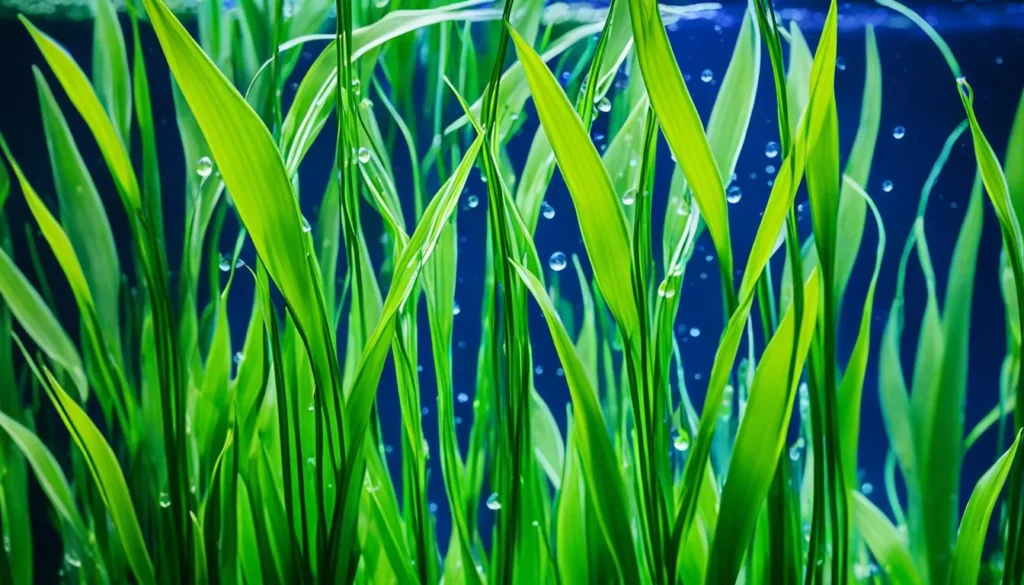
They coexist harmoniously, contributing to an aesthetically pleasing and balanced tank environment.
Nutritional Requirements Of The Plant
- This plant requires a mix of macro and micronutrients to support its growth. Macro nutrients, such as nitrogen (N), phosphorus (P), and potassium (K), are essential for its overall vitality. These nutrients play a key role in facilitating photosynthesis, which is vital for the plant’s energy production. These macronutrients can lead to stunted growth and pale leaves.
- Additionally, This plant benefits from the presence of micronutrients, which are essential in smaller quantities. Micronutrients include iron (Fe), manganese (Mn), and zinc (Zn), among others. These micronutrients are involved in important metabolic processes and contribute to the plant’s overall health and coloration.
- To ensure that the plant receives an adequate supply of nutrients, you can use aquatic plant fertilizers specifically formulated for aquarium plants. These fertilizers typically contain a balanced blend of macro and micronutrients, providing the essential elements necessary for the plant’s growth. Be sure to follow the manufacturer’s instructions when applying fertilizers to avoid overdosing, which can harm the plant and the aquarium ecosystem.
Cultivating Plant At Home
Now that you have learned about the fascinating this plant, you might be eager to bring its underwater elegance into your own home aquarium.
Cultivating this captivating aquatic plant is a rewarding endeavor that can enhance the beauty and vitality of your aquatic ecosystem.
In this section, we will guide you on how to successfully cultivate this plant at home, including propagation methods and planting techniques.
Propagation Methods
- Runners: This plant naturally produces runners, which are long stems that branch out from the main plant. These runners grow horizontally along the substrate, eventually creating new daughter plants. To propagate Vallisneria Neotropical using runners, simply wait for the new daughter plants to establish their own root systems before detaching them from the parent plant.
- Division: Another effective propagation method for this plant is division. This involves separating the plant into smaller sections, each with its own root system. Carefully remove the plant from the substrate and use scissors to divide the rhizome into individual sections, ensuring that each section has healthy leaves and roots. Plant the divided sections in the desired locations in your aquarium.
Planting Techniques
- Prepare the substrate: This plant thrives in nutrient-rich substrates such as gravel or sand. Before planting, ensure that the substrate is clean and free from debris. Additionally, consider adding a layer of plant-specific fertilizer to provide the necessary nutrients for growth.
- Planting depth: When planting Vallisneria Neotropical, bury the roots in the substrate while keeping the crown of the plant slightly above the surface. This will allow the leaves to reach the water column while providing stability to the plant.
- Spacing: Leave ample space between each plant to allow for their growth and prevent overcrowding. This will ensure that each plant receives sufficient light and nutrients.
- Lighting: Place this plant in an area of the aquarium where it will receive adequate lighting. This plant thrives in moderate to high-intensity light, which will support healthy photosynthesis and vibrant growth.
| Propagation Methods | Planting Techniques |
| Runners: New daughter plants grow from runners that branch out from the parent plant. | Prepare the substrate: Ensure it is clean and nutrient-rich. |
| Division: Divide the rhizome into smaller sections, each with its own roots. | Planting depth: Bury the roots in the substrate, keeping the crown slightly above the surface. |
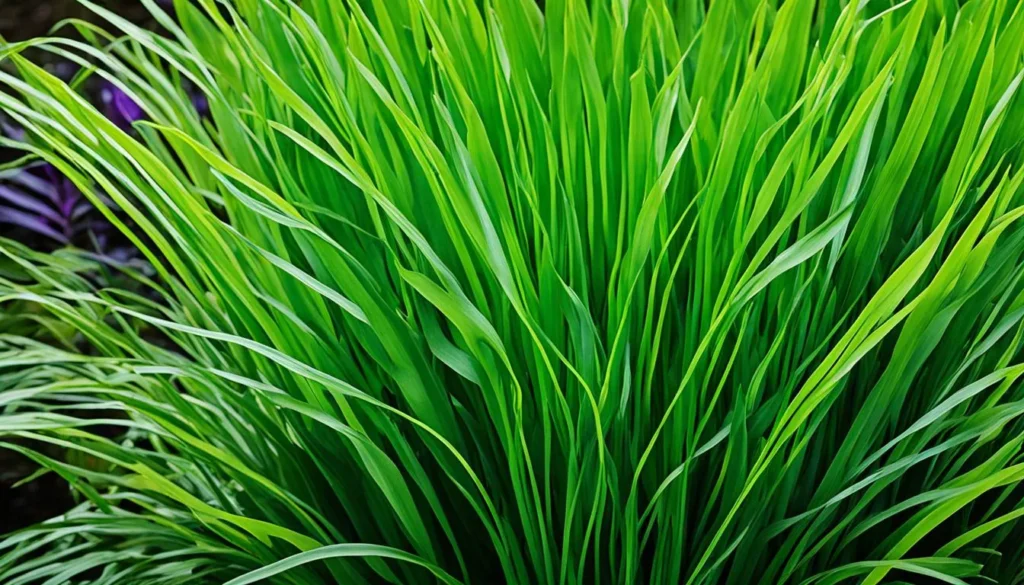
Plant Propagation Tips
If you’re looking to propagate Vallisneria Neotropical and expand your aquatic plant collection, there are a few essential propagation methods you can employ. Two common techniques for propagating this beautiful plant species are through runners and division.
Runners
- Gently separate the daughter plants from the runner using sterilized scissors or a sharp blade.
- Carefully plant the separated daughter plants into nutrient-rich substrate in your aquarium.
- Provide proper lighting and water conditions to ensure the successful growth of the propagated plants.
Division
- Remove the Vallisneria Neotropical plant from the aquarium carefully.
- Locate the rhizome, the horizontal stem connecting the roots and the plant’s leaves.
- Using a sharp, sterilized tool, divide the plant by cutting the rhizome into smaller sections.
- Ensure each section has an intact root system and a portion of the leaves.
- Plant the divided sections in nutrient-rich substrate, making sure to bury the rhizomes and roots.
- Maintain optimal lighting and water conditions for the divided sections to thrive and establish new growth.
RELATED: Echinodorus Red Flame To Aesthetically Design Your Aquarium
Benefits Of Planting Vallisneria Neotropical
- Planting Vallisneria Neotropical in your aquarium brings a multitude of benefits to the overall ecosystem and water quality. This elegant aquatic plant not only enhances the visual appeal of your tank but also contributes to the well-being of its inhabitants.
- One of the key advantages of Vallisneria Neotropical is its ability to oxygenate the water. As a photosynthetic plant, it releases oxygen into the surrounding water during daylight hours, creating a healthier environment for your fish and other aquatic organisms. This process also helps to maintain a balanced pH level in the aquarium, promoting the overall well-being of your aquatic life.
- Additionally, Vallisneria Neotropical plays a vital role in natural filtration. Its extensive root system absorbs excess nutrients, such as nitrogen and phosphorus, from the water column, effectively reducing the risk of algae blooms and maintaining water clarity. By removing these unwanted nutrients, Vallisneria Neotropical helps to prevent water pollution and maintain optimal water quality.
- Furthermore, this versatile plant provides important shelter and hiding places for small fish and invertebrates, offering a sense of security and promoting a more natural and harmonious habitat within the aquarium. The long and narrow leaves of Vallisneria Neotropical create hiding spots where fish can seek refuge, reducing stress levels and increasing their overall well-being.
Conclusion
We have explored the captivating underwater elegance of Vallisneria Neotropical, an aquatic plant that adds a touch of natural beauty and vitality to aquariums.
With its vibrant green color, long and narrow leaves, and graceful presence, Vallisneria Neotropical is a stunning addition to any underwater landscape.
Originating from freshwater ecosystems, Vallisneria Neotropical thrives in various temperature conditions and exhibits adaptability to different water parameters.
It requires proper lighting to support its photosynthetic needs and relies on a nutrient-rich substrate to promote optimal growth.
When placed strategically as a background plant or centerpiece, Vallisneria Neotropical creates a visually appealing aquatic environment.
Frequently Asked Questions
What Size Of Tank Is Suitable For Keeping Vallisneria Neotropical?
The tank size should be sufficient to accommodate the space requirements and growth potential of Vallisneria Neotropical.
Consider the plant’s height and spread when selecting an appropriate tank size.
What Are Suitable Tank Mates For Vallisneria Neotropical?
When selecting tank mates for Vallisneria Neotropical, it is important to choose peaceful fish and compatible species that will not damage or uproot the plant.
Consider its compatibility with other inhabitants in a community tank.
What Are The Nutritional Requirements Of Vallisneria Neotropical?
Vallisneria Neotropical requires both macro and micronutrients for healthy growth.
It can benefit from the use of aquatic plant fertilizers to provide essential nutrients for its development.
How Can Vallisneria Neotropical Be Propagated At Home?
Vallisneria Neotropical can be propagated through various methods, including the use of runners or by dividing existing plant clusters.
These techniques allow for the expansion and cultivation of the plant.
What Are The Benefits Of Planting Vallisneria Neotropical In An Aquarium?
Planting Vallisneria Neotropical in an aquarium enhances the overall aesthetic appeal of the tank, contributes to a healthier aquarium ecosystem, and helps maintain good water quality by absorbing excess nutrients.
- Unveiling The Wonders Of Riccia Fluitans In Aquascapes - August 7, 2024
- Vallisneria Gigantea Var. Guide To Care And Cultivation At Home - July 31, 2024
- Vesicularia Dubyana Care & Growth Guide Tips For Beginner Gardeners - July 30, 2024
